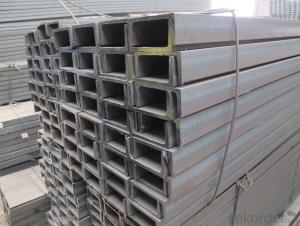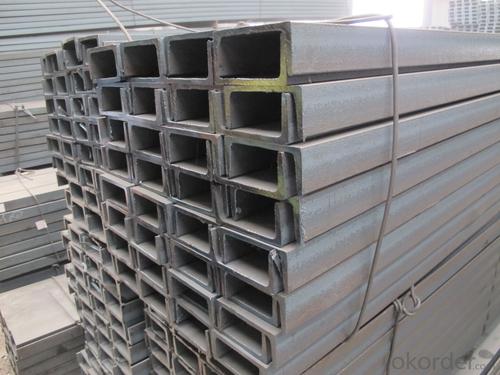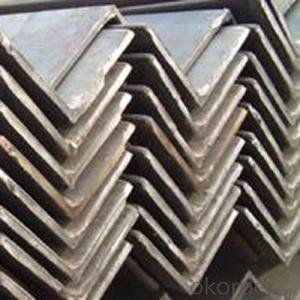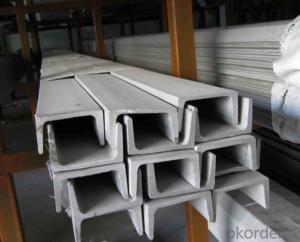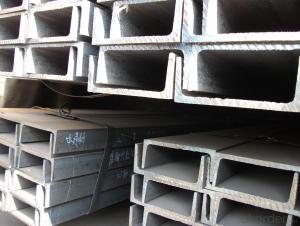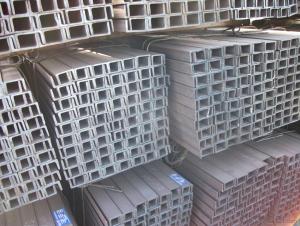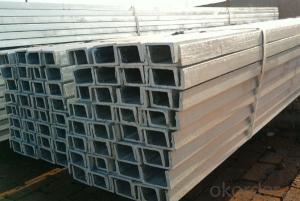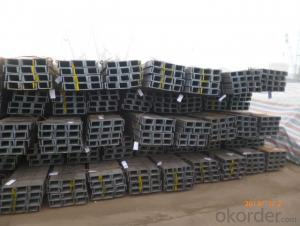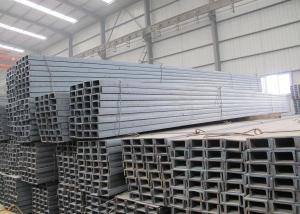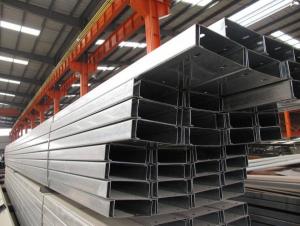Prime Low Carbon Hot Rolled JIS U Channel
- Loading Port:
- China Main Port
- Payment Terms:
- TT or LC
- Min Order Qty:
- 100 m.t.
- Supply Capability:
- 10000 m.t./month
OKorder Service Pledge
OKorder Financial Service
You Might Also Like
Product Description:
OKorder is offering Prime Low Carbon Hot Rolled JIS U Channel at great prices with worldwide shipping. Our supplier is a world-class manufacturer of steel, with our products utilized the world over. OKorder annually supplies products to African, South American and Asian markets. We provide quotations within 24 hours of receiving an inquiry and guarantee competitive prices.
Product Applications:
Prime Low Carbon Hot Rolled JIS U Channel are ideal for structural applications and are widely used in the construction of buildings and bridges, and the manufacturing, petrochemical, and transportation industries.
Product Advantages:
OKorder's Prime Low Carbon Hot Rolled JIS U Channel are durable, strong, and wide variety of sizes.
Main Product Features:
· Premium quality
· Prompt delivery & seaworthy packing (30 days after receiving deposit)
· Can be recycled and reused
· Mill test certification
· Professional Service
· Competitive pricing
Product Specifications:
Manufacture: Hot rolled
Grade: Q195 – 235
Certificates: ISO, SGS, BV, CIQ
Length: 6m-12m, as per customer request
Packaging: Export packing, nude packing, bundled
| JIS STANDARD CHANNEL | ||||||
| SIZE(MM) | h(mm) | b(mm) | s(mm) | t(mm) | kg/m | length |
| 50x25x3x6 | 50 | 25 | 3 | 6 | 2.37 | 6m,12m |
| 75X40x3.8x7 | 75 | 40 | 3.8 | 7 | 5.3 | 6m,12m |
| 75X40x4x7 | 75 | 40 | 4 | 7 | 5.6 | 6m,12m |
| 75X40x4.5x7 | 75 | 40 | 4.5 | 7 | 5.85 | 6m,12m |
| 75X40x5x7 | 75 | 40 | 5 | 7 | 6.92 | 6m,12m |
| 100X50x3.8x6 | 100 | 50 | 3.8 | 6 | 7.3 | 6m,12m |
| 100X50x4.2x6 | 100 | 50 | 4.2 | 6 | 8.03 | 6m,12m |
| 100X50x4.5x7.5 | 100 | 50 | 4.5 | 7.5 | 8.97 | 6m,12m |
| 100X50x5x7.5 | 100 | 50 | 5 | 7.5 | 9.36 | 6m,12m |
| 125X65x5.2x6.8 | 125 | 65 | 5.2 | 6.8 | 11.66 | 6m,12m |
| 125X65x5.3x6.8 | 125 | 65 | 5.3 | 6.8 | 12.17 | 6m,12m |
| 125X65x5.5x8 | 125 | 65 | 5.5 | 8 | 12.91 | 6m,12m |
| 125X65x6x8 | 125 | 65 | 6 | 8 | 13.4 | 6m,12m |
| 150x75x5.5x7.3 | 150 | 75 | 5.5 | 7.3 | 14.66 | 6m,12m |
| 150x75x5.7x10 | 150 | 75 | 5.7 | 10 | 16.71 | 6m,12m |
| 150x75x6x10 | 150 | 75 | 6 | 10 | 17.9 | 6m,12m |
| 150x75x6.5x10 | 150 | 75 | 6.5 | 10 | 18.6 | 6m,12m |
FAQ:
Q1: How many tons of steel products could be loaded in containers?
A1: Usually the steel products are delivered by bulk vessel because of the large quantity and the freight. However, there are no bulk vessel enter some seaports so that we have to deliver the cargo by containers. The 6m steel product can be loaded in 20FT container, but the quantity is changed according to the size, usually from 18tons to 25tons.
Q2: How do we guarantee the quality of our products?
A2: We have established an advanced quality management system which conducts strict quality tests at every step, from raw materials to the final product. At the same time, we provide extensive follow-up service assurances as required.
Q3: How soon can we receive the product after purchase?
A3: Within three days of placing an order, we will arrange production. The normal sizes with the normal grade can be produced within one month. The specific shipping date is dependent upon international and government factors, the delivery to international main port about 45-60days.
Images:
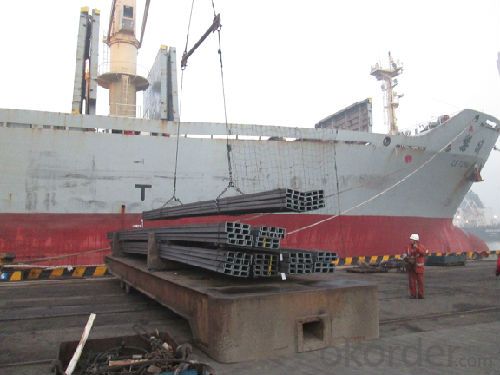
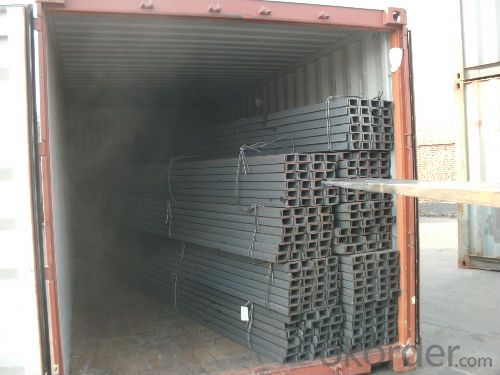
- Q: How do steel channels contribute to the overall safety of a structure?
- Steel channels contribute to the overall safety of a structure in several ways. Firstly, steel channels provide structural support and stability to the building. They are often used as load-bearing members in the construction industry, helping to distribute the weight of the structure evenly and efficiently. This ensures that the building can withstand various external forces such as wind, earthquakes, and heavy loads without collapsing. By providing a strong framework, steel channels enhance the overall safety and structural integrity of the building. Secondly, steel channels play a crucial role in fire safety. Steel is a non-combustible material, and when used as channels, it can help prevent the spread of fire within a structure. In the event of a fire, steel channels act as fire barriers, restricting the movement of flames and heat to specific areas. This containment helps to limit the damage caused by fire and provides occupants with more time to evacuate safely. Additionally, steel channels are resistant to corrosion and deterioration, making them highly durable and reliable. Unlike other materials, steel does not rot, warp, or degrade over time. This longevity ensures that the structure remains stable and secure in the long run, reducing the risk of accidents and structural failures. Furthermore, steel channels are often used in the construction of seismic-resistant structures. With their high strength and flexibility, steel channels can absorb and dissipate seismic energy during an earthquake. This ability to withstand seismic forces helps to minimize structural damage and ensures the safety of the occupants within the building. In conclusion, steel channels contribute significantly to the overall safety of a structure by providing structural support, fire resistance, durability, and seismic resistance. Their use in construction enhances the stability, strength, and integrity of the building, ensuring the safety and well-being of its occupants.
- Q: What are the different methods for reinforcing steel channels?
- There are several methods for reinforcing steel channels, depending on the specific requirements and applications. Some of the common methods include: 1. Welding: Welding is a widely used method for reinforcing steel channels. It involves attaching additional steel plates or bars to the existing channel using high heat generated by an electric arc. This method provides a strong bond and ensures structural integrity. 2. Bolting: Bolting is another method used to reinforce steel channels. It involves attaching additional steel plates or bars to the channel using bolts and nuts. This method is relatively easier to implement and allows for easy removal or adjustment if required. 3. Adhesive bonding: Adhesive bonding is a technique that involves using industrial-grade adhesives to bond additional steel plates or bars to the steel channel. This method offers a strong bond and is often used in applications where welding or bolting may not be feasible or desired. 4. Fiber reinforced polymers (FRP): FRP composites, such as carbon fiber or fiberglass, can be used to reinforce steel channels. These materials are lightweight, high-strength, and corrosion-resistant, making them ideal for strengthening channels in corrosive environments or where weight is a concern. 5. Shotcreting: Shotcreting is a method that involves spraying a mixture of cement, sand, and reinforcing fibers onto the surface of the steel channel. This creates a layer of reinforced concrete that enhances the strength and durability of the channel. 6. Encasement: In some cases, steel channels may be reinforced by encasing them in concrete. This method involves pouring concrete around the channel, creating a composite structure that combines the strength of both materials. 7. Pre-stressing: Pre-stressing is a technique that involves applying tension to the steel channel before it is loaded. This can be done using pre-stressed steel strands or bars, which are anchored at the ends of the channel. The pre-stressing force helps to counteract the tensile forces that the channel may experience during use. It is important to note that the selection of the appropriate method for reinforcing steel channels depends on factors such as the load requirements, environmental conditions, cost, and feasibility. Consulting with a structural engineer or expert is recommended to ensure the chosen method meets the specific needs of the application.
- Q: Can steel channels be used in industrial buildings?
- Industrial buildings can utilize steel channels for various purposes. Known as C-channels or U-channels, steel channels are steel structural members that come in a C or U shape. They are commonly employed in construction and industrial settings due to their strength and adaptability. Within industrial buildings, steel channels find use in multiple ways. They often serve as support beams or columns, providing structural stability and the ability to bear heavy loads. By effectively distributing the weight of machinery, equipment, and materials, steel channels meet the demands of industrial applications where robust and durable structural components are necessary. Moreover, steel channels can be applied to frame walls, roofs, and floors in industrial buildings. They can be conveniently connected and welded together to form rigid and stable frames. Given their ability to be cut and shaped according to specific requirements and specifications, steel channels offer design flexibility. In addition, steel channels demonstrate excellent resistance to corrosion, making them a suitable choice for industrial environments exposed to moisture, chemicals, or other harsh conditions. With a long lifespan and low maintenance needs, steel channels prove advantageous for industrial buildings that undergo heavy use and demanding operations. In summary, the strength, versatility, and corrosion resistance of steel channels make them a popular choice in industrial buildings. They provide structural stability, support heavy loads, and offer design flexibility. Whether utilized as support beams, framing components, or in other applications, steel channels effectively meet the requirements of industrial buildings.
- Q: How do steel channels contribute to the overall strength of a structure?
- There are multiple ways in which steel channels contribute to the overall strength of a structure. To begin with, they offer structural support and stability by evenly distributing the load across the structure. The shape of steel channels, which includes a wide base and tapered edges, allows them to bear more weight and resist bending or buckling when faced with heavy loads. Moreover, steel channels enhance the rigidity of a structure by preventing lateral movement or twisting. They function as beams, establishing a framework that combats deformation and ensures the structure maintains its shape and integrity, even under challenging circumstances like earthquakes or strong winds. Furthermore, steel channels can be strategically positioned in crucial areas of a structure, such as load-bearing walls or columns, to reinforce these vulnerable points. This reinforcement significantly increases the overall strength and durability of the structure, reducing the risk of structural failure. In addition, steel channels possess high tensile strength, enabling them to withstand stretching or elongation when subjected to tension. This property is particularly important for structures that encounter dynamic loads, like bridges or tall buildings. Steel channels play a role in distributing and absorbing these dynamic forces, preventing excessive deflection or deformation that could jeopardize the stability of the structure. In conclusion, the contribution of steel channels to the overall strength of a structure is significant. They provide structural support, enhance rigidity, reinforce vulnerable points, and offer high tensile strength. Their ability to distribute loads, resist bending or buckling, and withstand dynamic forces makes them an essential component of any robust and long-lasting structure.
- Q: What are the different types of steel channel supports?
- In construction and engineering projects, various types of steel channel supports are commonly utilized to ensure structural stability and support. These supports serve different purposes and can be categorized as follows: 1. C-Channel Supports: These supports possess exceptional strength and rigidity due to their "C" shape. They are frequently employed in industrial settings to bear the weight of heavy equipment and machinery. 2. U-Channel Supports: Similar to C-channel supports, U-channel supports are shaped like a "U" and offer versatility. They can be used for framing and bracing structures in a wide range of applications. 3. Back-to-Back Channel Supports: Comprising two parallel channels welded together, these supports provide enhanced strength and stability. They are commonly employed in applications that require additional load-bearing capacity. 4. Slotted Channel Supports: These supports feature slots along the length of the channel, enabling easy adjustment and flexibility. They find utility in applications where the position of the support needs to be altered. 5. Strut Channel Supports: Also known as strut or framing channel supports, these supports are designed with specialized channels that facilitate the attachment of fittings and accessories. They are frequently utilized in electrical and mechanical installations. 6. Adjustable Channel Supports: These supports incorporate telescoping or adjustable sections for height and width adjustment. They are commonly used in applications that demand adaptability to changing requirements. 7. Stainless Steel Channel Supports: Manufactured from corrosion-resistant stainless steel, these supports are ideal for use in harsh or corrosive environments. These examples represent only a fraction of the available types of steel channel supports. Each type offers distinct features and benefits, enabling their utilization in various industries. The choice of support depends on the specific requirements of the project and the necessary load-bearing capacity.
- Q: Are steel channels suitable for use in warehouse storage systems?
- Indeed, warehouse storage systems can make effective use of steel channels. Steel channels offer a robust and enduring structure that can bear the weight of heavy loads within a warehouse. They possess the capability to withstand the pressure generated by diverse storage items, and can be employed in various storage arrangements, including pallet racking systems, shelving units, or mezzanine platforms. Steel channels exhibit resistance to harm, corrosion, and wear, thereby guaranteeing an extended lifespan for the storage system. Moreover, they can be conveniently personalized and altered to suit different storage requirements and configurations, rendering them a flexible option for warehouse storage systems.
- Q: Are steel channels resistant to pests and rodents?
- Steel channels are highly resistant to pests and rodents. Unlike other materials such as wood, steel does not provide a food source or nesting material for pests and rodents. Its smooth surface and hard structure make it difficult for them to chew through or gain access to. Additionally, steel channels are often used in construction and industrial applications where hygiene and cleanliness are important, further deterring pests and rodents. Overall, steel channels provide an effective barrier against infestation and are a reliable choice for preventing pest and rodent issues.
- Q: How do steel channels perform in high-vibration areas?
- Steel channels are renowned for their exceptional strength and durability, rendering them suitable for a multitude of applications. In areas characterized by high levels of vibration, steel channels exhibit exceptional performance owing to their inherent stiffness and rigidity. The presence of vibration can induce structural instability and harm weaker materials; however, steel channels possess the capability to efficiently absorb and dissipate vibrations. This attribute is particularly crucial in settings such as industrial facilities, bridges, and heavy machinery installations, where vibrations are frequently encountered. Steel channels are designed to resist deformation and maintain their shape when subjected to dynamic loads, including vibrations. They boast high torsional and bending stiffness, thereby minimizing deflection and preserving structural integrity. Consequently, these channels can endure constant and repetitive vibrations without compromising their performance. Furthermore, vibration dampening techniques can be employed to further enhance steel channels. These techniques involve the utilization of specialized materials or coatings specifically crafted to absorb and diminish vibrations. By incorporating such measures, steel channels effectively alleviate excessive vibrations, ensuring the safety and longevity of the structure. In conclusion, steel channels are an exceptional choice for areas prone to high levels of vibration due to their innate strength, rigidity, and capacity to absorb vibrations. Their superior performance under dynamic loads, coupled with the potential utilization of vibration dampening techniques, renders them a reliable and enduring solution in such environments.
- Q: What are the different types of bracing systems used with steel channels?
- Steel channels can be combined with various bracing systems to meet the specific needs and requirements of a project. The following are a few examples: 1. Cross bracing: The most commonly used bracing system for steel channels involves diagonal members or cables arranged in a crisscross pattern between two or more steel channels. This type of bracing ensures an even distribution of the load and enhances the stability of the structure. 2. K-bracing: Rectangular or square buildings often employ K-bracing, which involves diagonal members or cables forming a K-shape between steel channels. It offers strong resistance against lateral forces. 3. Chevron bracing: Similar to K-bracing, chevron bracing also utilizes diagonal members or cables. However, in this system, the diagonal members form a V-shape or chevron pattern. Chevron bracing is ideal for structures with limited space, as it requires less material and allows for more open floor plans. 4. X-bracing: This bracing system uses diagonal members or cables arranged in an X-shape between steel channels. It is popularly used in buildings with long spans or high wind loads due to its excellent resistance against lateral forces. 5. Portal bracing: Buildings with large openings, such as garages or warehouses, often incorporate portal bracing. This involves adding diagonal members or cables to create a portal frame between steel channels. The purpose of this type of bracing is to distribute the load evenly and prevent deformation of the structure. 6. Eccentric bracing: Eccentric bracing is a specialized system that allows for controlled yielding during seismic events. It involves placing diagonal members or cables off-center from the vertical axis of the steel channels. This arrangement dissipates energy and minimizes the impact of seismic forces. These are just a few examples of the bracing systems compatible with steel channels. The choice of bracing system depends on factors such as structural requirements, building codes, and project-specific needs.
- Q: Can steel channels be used for supporting heavy equipment?
- Yes, steel channels can be used for supporting heavy equipment. Steel channels are commonly used in construction and industrial applications for their strength and load-bearing capacity. They are designed to provide structural support and can withstand heavy loads and forces. Steel channels are often used as beams, columns, or supports in buildings, bridges, machinery, and equipment. They are preferred for supporting heavy equipment due to their durability, stability, and ability to distribute weight effectively. However, it is essential to ensure that the specific steel channel used is appropriate for the weight and dimensions of the equipment being supported. Engineering calculations and considerations should be made to determine the suitable size, shape, and thickness of the steel channel to ensure it can adequately support the heavy equipment.
Send your message to us
Prime Low Carbon Hot Rolled JIS U Channel
- Loading Port:
- China Main Port
- Payment Terms:
- TT or LC
- Min Order Qty:
- 100 m.t.
- Supply Capability:
- 10000 m.t./month
OKorder Service Pledge
OKorder Financial Service
Similar products
Hot products
Hot Searches
Related keywords
